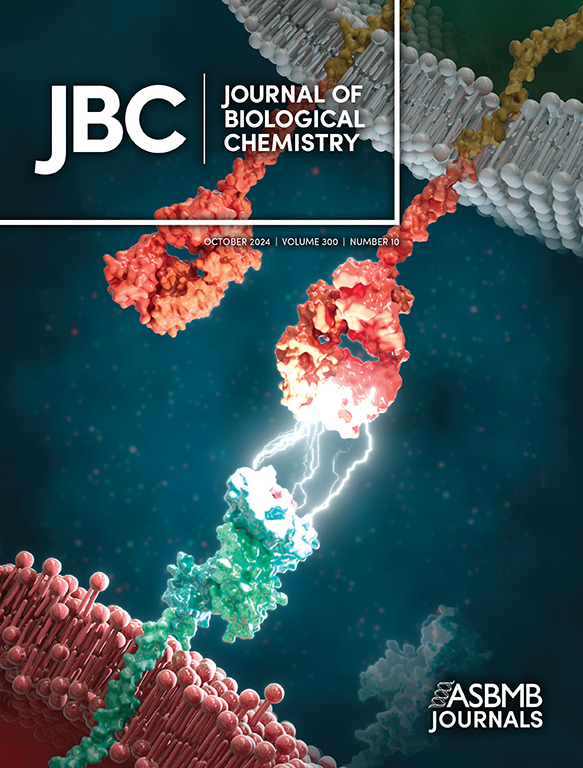蛋白精氨酸脱亚胺酶4与肌球蛋白-9运动复合物的关联。
IF 4
2区 生物学
Q2 BIOCHEMISTRY & MOLECULAR BIOLOGY
引用次数: 0
摘要
遗传关联数据、免疫组织化学和功能实验表明,蛋白精氨酸脱亚胺酶4 (PAD4)参与类风湿关节炎(RA)的发病机制。这种疾病的特点是对源自大量细胞内和细胞外蛋白的去亚胺精氨酸(=瓜氨酸)表位具有免疫力,这些蛋白仅在RA患者中以这种方式修饰,而在健康个体中则没有。然而,目前尚不清楚PAD4在RA患者中如何、在何处以及为什么使这些蛋白氨酸化。为了深入了解PAD4与其他细胞蛋白的物理相互作用,我们通过质谱法鉴定了候选PAD4相关蛋白。来自RA患者和健康对照者的中性粒细胞中的PAD4与肌球蛋白-9和其他20种蛋白质共同免疫沉淀,其中许多也存在于肌球蛋白-9免疫沉淀中。免疫荧光显微镜下,PAD4与RA中性粒细胞中的肌球蛋白-9、肌球蛋白轻链6和其他相关蛋白共定位。在完整的中性粒细胞中进行近端结扎试验证实了这一点。blebbistatin抑制myosin-9的运动结构域导致更分散的PAD4位置,表明myosin-9在细胞内运输PAD4。然而,PAD4向细胞核的移位涉及与肌球蛋白-9的分离。与PAD4复合物,肌球蛋白-9在RA患者的n端和c端位点均被瓜氨酸化,但在健康对照中没有。这些位点对应的瓜氨酸肽可被RA患者的IgG自身抗体识别。我们得出结论,中性粒细胞中至少有一部分细胞内PAD4与含有肌球蛋白-9的大分子机制进行物理和催化相互作用,参与细胞迁移和细胞器和膜的运输。(248字)。本文章由计算机程序翻译,如有差异,请以英文原文为准。
Association of protein arginine deiminase 4 with the myosin-9 motor complex.
Genetic association data, immunohistochemistry, and functional experiments implicate protein arginine deiminase 4 (PAD4) in the pathogenesis of rheumatoid arthritis (RA). This disease is characterized by immunity against epitopes with deiminated arginine (=citrulline) originating from a multitude of intra-and extracellular proteins that are modified in this manner only in RA patients, not in healthy individuals. However, it remains uncertain how, where, and why PAD4 citrullinates these proteins in the RA patients. To gain insights into the physical interactions of PAD4 with other cellular proteins, we identified candidate PAD4-associated proteins by mass spectrometry. PAD4 in neutrophils from RA patients and healthy controls co-immunoprecipitated with myosin-9, and 20 other proteins, many of which were also present in myosin-9 immunoprecipitates. By immunofluorescence microscopy, PAD4 co-localized with myosin-9, myosin light chain 6, and other associated proteins in RA neutrophils. This was confirmed by proximity ligation assays in intact neutrophils. Inhibition of the motor domain of myosin-9 by blebbistatin resulted in a more diffuse PAD4 location indicating that myosin-9 serves to transport PAD4 within the cells. However, PAD4 translocation to the nucleus involved dissociation from myosin-9. In complex with PAD4, myosin-9 was citrullinated at both N-terminal and C-terminal sites in RA patients, but not in healthy controls. Citrullinated peptides corresponding to these sites were recognized by IgG autoantibodies in RA patients. We conclude that at least a portion of intracellular PAD4 in neutrophils interacts physically and catalytically with a myosin-9 containing macromolecular machinery involved in the cell migration and transport of organelles and membrane. (248 words).
求助全文
通过发布文献求助,成功后即可免费获取论文全文。
去求助
来源期刊

Journal of Biological Chemistry
Biochemistry, Genetics and Molecular Biology-Biochemistry
自引率
4.20%
发文量
1233
期刊介绍:
The Journal of Biological Chemistry welcomes high-quality science that seeks to elucidate the molecular and cellular basis of biological processes. Papers published in JBC can therefore fall under the umbrellas of not only biological chemistry, chemical biology, or biochemistry, but also allied disciplines such as biophysics, systems biology, RNA biology, immunology, microbiology, neurobiology, epigenetics, computational biology, ’omics, and many more. The outcome of our focus on papers that contribute novel and important mechanistic insights, rather than on a particular topic area, is that JBC is truly a melting pot for scientists across disciplines. In addition, JBC welcomes papers that describe methods that will help scientists push their biochemical inquiries forward and resources that will be of use to the research community.
 求助内容:
求助内容: 应助结果提醒方式:
应助结果提醒方式:


